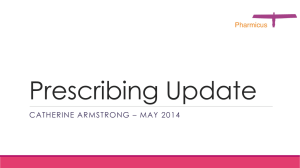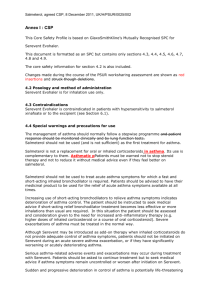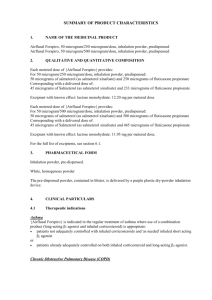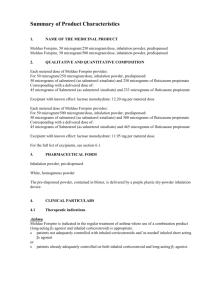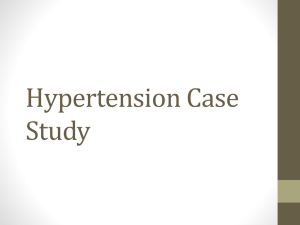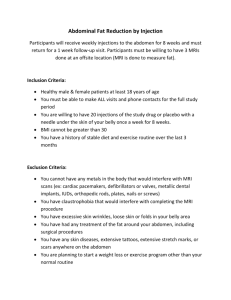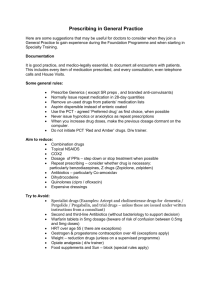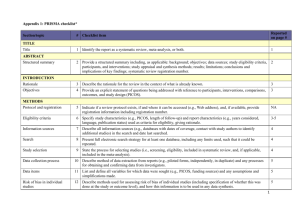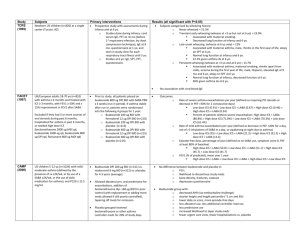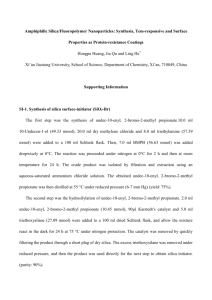Salmeterol xinafoate - Fluticasone Propionate
advertisement
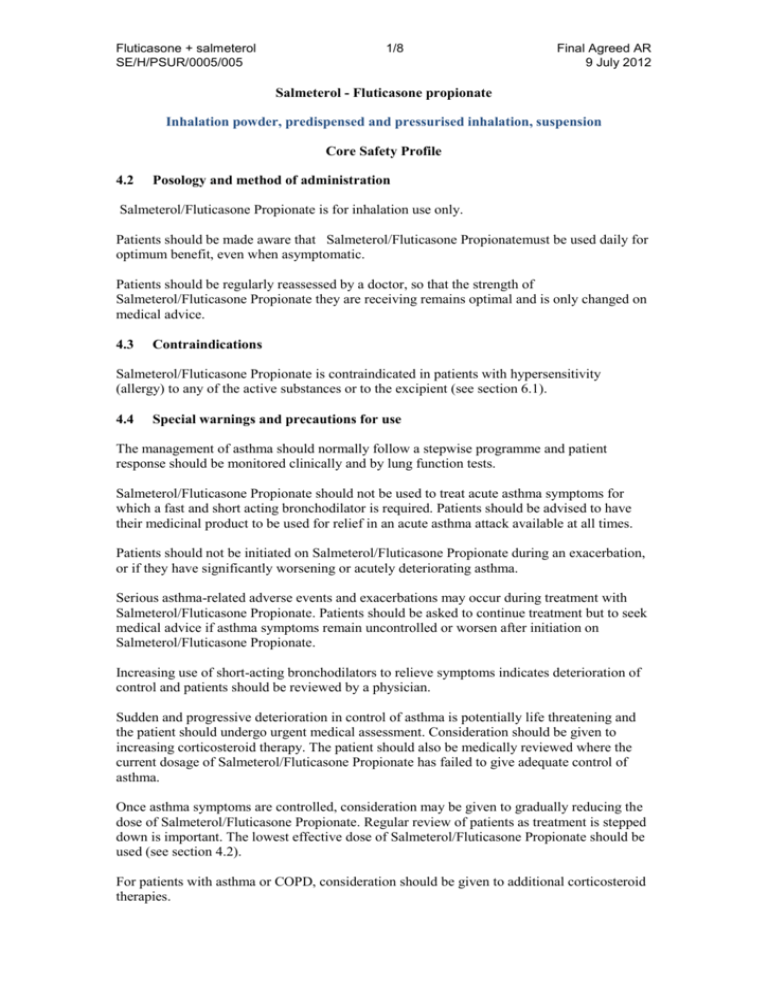
Fluticasone + salmeterol SE/H/PSUR/0005/005 1/8 Final Agreed AR 9 July 2012 Salmeterol - Fluticasone propionate Inhalation powder, predispensed and pressurised inhalation, suspension Core Safety Profile 4.2 Posology and method of administration Salmeterol/Fluticasone Propionate is for inhalation use only. Patients should be made aware that Salmeterol/Fluticasone Propionatemust be used daily for optimum benefit, even when asymptomatic. Patients should be regularly reassessed by a doctor, so that the strength of Salmeterol/Fluticasone Propionate they are receiving remains optimal and is only changed on medical advice. 4.3 Contraindications Salmeterol/Fluticasone Propionate is contraindicated in patients with hypersensitivity (allergy) to any of the active substances or to the excipient (see section 6.1). 4.4 Special warnings and precautions for use The management of asthma should normally follow a stepwise programme and patient response should be monitored clinically and by lung function tests. Salmeterol/Fluticasone Propionate should not be used to treat acute asthma symptoms for which a fast and short acting bronchodilator is required. Patients should be advised to have their medicinal product to be used for relief in an acute asthma attack available at all times. Patients should not be initiated on Salmeterol/Fluticasone Propionate during an exacerbation, or if they have significantly worsening or acutely deteriorating asthma. Serious asthma-related adverse events and exacerbations may occur during treatment with Salmeterol/Fluticasone Propionate. Patients should be asked to continue treatment but to seek medical advice if asthma symptoms remain uncontrolled or worsen after initiation on Salmeterol/Fluticasone Propionate. Increasing use of short-acting bronchodilators to relieve symptoms indicates deterioration of control and patients should be reviewed by a physician. Sudden and progressive deterioration in control of asthma is potentially life threatening and the patient should undergo urgent medical assessment. Consideration should be given to increasing corticosteroid therapy. The patient should also be medically reviewed where the current dosage of Salmeterol/Fluticasone Propionate has failed to give adequate control of asthma. Once asthma symptoms are controlled, consideration may be given to gradually reducing the dose of Salmeterol/Fluticasone Propionate. Regular review of patients as treatment is stepped down is important. The lowest effective dose of Salmeterol/Fluticasone Propionate should be used (see section 4.2). For patients with asthma or COPD, consideration should be given to additional corticosteroid therapies. Fluticasone + salmeterol SE/H/PSUR/0005/005 2/8 Final Agreed AR 9 July 2012 Treatment with Salmeterol/Fluticasone Propionate should not be stopped abruptly in patients with asthma due to risk of exacerbation. Therapy should be down-titrated under physician supervision. For patients with COPD cessation of therapy may also be associated with symptomatic decompensation and should be supervised by a physician. As with all inhaled medication containing corticosteroids, Salmeterol/Fluticasone Propionate should be administered with caution in patients with pulmonary tuberculosis. Rarely, Salmeterol/Fluticasone Propionate may cause cardiac arrhythmias e.g. supraventricular tachycardia, extrasystoles and atrial fibrillation, and a mild transient reduction in serum potassium at high therapeutic doses. Therefore Salmeterol/Fluticasone Propionate should be used with caution in patients with severe cardiovascular disorders, heart rhythm abnormalities, diabetes mellitus, thyrotoxicosis, uncorrected hypokalaemia or patients predisposed to low levels of serum potassium. There have been very rare reports of increases in blood glucose levels (see section 4.8) and this should be considered when prescribing to patients with a history of diabetes mellitus. As with other inhalation therapy paradoxical bronchospasm may occur with an immediate increase in wheezing after dosing. Salmeterol/Fluticasone Propionate should be discontinued immediately, the patient assessed and alternative therapy instituted if necessary. Salmeterol/Fluticasone Propionate contains lactose up to 12.5 milligram /dose. This amount does not normally cause problems in lactose intolerant people. Systemic effects may occur with any inhaled corticosteroid, particularly at high doses prescribed for long periods. These effects are much less likely to occur than with oral corticosteroids. Possible systemic effects include Cushing’s syndrome, Cushingoid features, adrenal suppression, decrease in bone mineral density, cataract and glaucoma and more rarely, a range of psychological or behavioural effects including psychomotor hyperactivity, sleep disorders, anxiety, depression or aggression (particularly in children). It is important, therefore, that the patient is reviewed regularly and the dose of inhaled corticosteroid is reduced to the lowest dose at which effective control of asthma is maintained. Prolonged treatment of patients with high doses of inhaled corticosteroids may result in adrenal suppression and acute adrenal crisis. Very rare cases of adrenal suppression and acute adrenal crisis have also been described with doses of fluticasone propionate between 500 and less than 1000 micrograms. Situations, which could potentially trigger acute adrenal crisis include trauma, surgery, infection or any rapid reduction in dosage. Presenting symptoms are typically vague and may include anorexia, abdominal pain, weight loss, tiredness, headache, nausea, vomiting, hypotension, decreased level of consciousness, hypoglycaemia, and seizures. Additional systemic corticosteroid cover should be considered during periods of stress or elective surgery. The benefits of inhaled fluticasone propionate therapy should minimise the need for oral steroids, but patients transferring from oral steroids may remain at risk of impaired adrenal reserve for a considerable time. Patients who have required high dose emergency corticosteroid therapy in the past may also be at risk. This possibility of residual impairment should always be borne in mind in emergency and elective situations likely to produce stress, and appropriate corticosteroid treatment must be considered. The extent of the adrenal impairment may require specialist advice before elective procedures. Ritonavir can greatly increase the concentration of fluticasone propionate in plasma. Therefore, concomitant use should be avoided, unless the potential benefit to the patient Fluticasone + salmeterol SE/H/PSUR/0005/005 3/8 Final Agreed AR 9 July 2012 outweighs the risk of systemic corticosteroid side-effects. There is also an increased risk of systemic side effects when combining fluticasone propionate with other potent CYP3A inhibitors (see section 4.5). There was an increased reporting of lower respiratory tract infections (particularly pneumonia and bronchitis) in the TORCH study in patients with COPD receiving Salmeterol/Fluticasone Propionate 50/500 micrograms bd compared with placebo as well as in studies SCO40043 and SCO1000250 comparing the lower non-approved COPD dose of Salmeterol/Fluticasone Propionate, 50/250 micrograms bd, to salmeterol 50 micrograms bd only (see section 4.8 and 5.1). A similar incidence of pneumonia in the Salmeterol/Fluticasone Propionate group was seen across all studies. In TORCH, older patients, patients with a lower body mass index (<25kg/m2) and patients with very severe disease (FEV1<30% predicted) were at greatest risk of developing pneumonia regardless of treatment. Physicians should remain vigilant for the possible development of pneumonia and other lower respiratory tract infections in patients with COPD as the clinical features of such infections and exacerbation frequently overlap. If a patient with severe COPD has experienced pneumonia the treatment with Salmeterol/Fluticasone Propionate should be re-evaluated. Data from a large clinical trial (the Salmeterol Multi-Center Asthma Research Trial, SMART) suggested African-American patients were at increased risk of serious respiratory-related events or deaths when using salmeterol compared with placebo (see section 5.1). It is not known if this was due to pharmacogenetic or other factors. Patients of black African or AfroCaribbean ancestry should therefore be asked to continue treatment but to seek medical advice if asthma symptoms remained uncontrolled or worsen whilst using Salmeterol/Fluticasone Propionate. Concomitant use of systemic ketoconazole significantly increases systemic exposure to salmeterol. This may lead to an increase in the incidence of systemic effects (e.g. prolongation in the QTc interval and palpitations). Concomitant treatment with ketoconazole or other potent CYP3A4 inhibitors should therefore be avoided unless the benefits outweigh the potentially increased risk of systemic side effects of salmeterol treatment (see section 4.5). Paediatric population Children and adolescents <16years taking high doses of fluticasone propionate (typically 1000 micrograms/day) may be at particular risk of systemic effects. Systemic effects may occur, particularly at high doses prescribed for long periods. Possible systemic effects include Cushing’s syndrome, Cushingoid features, adrenal suppression, acute adrenal crisis and growth retardation in children and adolescents and more rarely, a range of psychological or behavioural effects including psychomotor hyperactivity, sleep disorders, anxiety, depression or aggression. It is recommended that the height of children receiving prolonged treatment with inhaled corticosteroid is regularly monitored. The dose of inhaled corticosteroid should be reduced to the lowest dose at which effective control of asthma is maintained. 4.5 Interaction with other medicinal products and other forms of interaction Both non-selective and selective beta-blockers should be avoided unless there are compelling reasons for their use. Concomitant use of other beta-adrenergic containing drugs can have a potentially additive effect. Fluticasone + salmeterol SE/H/PSUR/0005/005 4/8 Final Agreed AR 9 July 2012 Fluticasone Propionate Under normal circumstances, low plasma concentrations of fluticasone propionate are achieved after inhaled dosing, due to extensive first pass metabolism and high systemic clearance mediated by cytochrome P450 3A4 in the gut and liver. Hence, clinically significant drug interactions mediated by fluticasone propionate are unlikely. In an interaction study in healthy subjects with intranasal fluticasone propionate, ritonavir (a highly potent cytochrome P450 3A4 inhibitor) 100 mg b.i.d. increased the fluticasone propionate plasma concentrations several hundred fold, resulting in markedly reduced serum cortisol concentrations. Information about this interaction is lacking for inhaled fluticasone propionate, but a marked increase in fluticasone propionate plasma levels is expected. Cases of Cushing’s syndrome and adrenal suppression have been reported. The combination should be avoided unless the benefit outweighs the increased risk of systemic glucocorticoid sideeffects. In a small study in healthy volunteers, the slightly less potent CYP3A inhibitor ketoconazole increased the exposure of fluticasone propionate after a single inhalation by 150%. This resulted in a greater reduction of plasma cortisol as compared with fluticasone propionate alone. Co-treatment with other potent CYP3A inhibitors, such as itraconazole, is also expected to increase the systemic fluticasone propionate exposure and the risk of systemic side-effects. Caution is recommended and long-term treatment with such drugs should if possible be avoided. Salmeterol Potent CYP3A4 inhibitors Co-administration of ketoconazole (400 mg orally once daily) and salmeterol (50 micrograms inhaled twice daily) in 15 healthy subjects for 7 days resulted in a significant increase in plasma salmeterol exposure (1.4-fold Cmax and 15-fold AUC). This may lead to an increase in the incidence of other systemic effects of salmeterol treatment (e.g. prolongation of QTc interval and palpitations) compared with salmeterol or ketoconazole treatment alone (see Section 4.4). Clinically significant effects were not seen on blood pressure, heart rate, blood glucose and blood potassium levels. Co-administration with ketoconazole did not increase the elimination half-life of salmeterol or increase salmeterol accumulation with repeat dosing. The concomitant administration of ketoconazole should be avoided, unless the benefits outweigh the potentially increased risk of systemic side effects of salmeterol treatment. There is likely to be a similar risk of interaction with other potent CYP3A4 inhibitors (e.g. itraconazole, telithromycin, ritonavir). Moderate CYP 3A4 inhibitors Co-administration of erythromycin (500mg orally three times a day) and salmeterol (50 micrograms inhaled twice daily) in 15 healthy subjects for 6 days resulted in a small but nonstatistically significant increase in salmeterol exposure (1.4-fold Cmax and 1.2-fold AUC). Co-administration with erythromycin was not associated with any serious adverse effects. 4.6 Fertility, pregnancy and lactation Fertility There are no data in humans. However, animal studies showed no effects of salmeterol or fluticasone propionate on fertility. Fluticasone + salmeterol SE/H/PSUR/0005/005 5/8 Final Agreed AR 9 July 2012 Pregnancy A moderate amount of data on pregnant women (between 300-1000 pregnancy outcomes) indicate no malformative or feto/neonatal toxicity of salmeterol and fluticasone propionate. Animal studies have shown reproductive toxicity after administration of beta-2adrenoreceptor agonists and glucocorticosteroids (see section 5.3). Administration of Salmeterol/Fluticasone Propionate to pregnant women should only be considered if the expected benefit to the mother is greater than any possible risk to the foetus. The lowest effective dose of fluticasone propionate needed to maintain adequate asthma control should be used in the treatment of pregnant women. Lactation It is unknown whether salmeterol and fluticasone propionate/metabolites are excreted in human milk. Studies have shown that salmeterol and fluticasone propionate, and their metabolites, are excreted into the milk of lactating rats. A risk to breastfed newborns/infants cannot be excluded. A decision must be made whether to discontinue breast-feeding or to discontinue Salmeterol/Fluticasone Propionate therapy taking into account the benefit of breast-feeding for the child and the benefit of therapy for the woman. 4.7 Effects on ability to drive and use machines No studies of the effect on the ability to drive and use machines have been performed. 4.8 Undesirable effects As Salmeterol/Fluticasone Propionate contains salmeterol and fluticasone propionate, the type and severity of adverse reactions associated with each of the compounds may be expected. There is no incidence of additional adverse events following concurrent administration of the two compounds. Adverse events which have been associated with salmeterol/fluticasone propionate are given below, listed by system organ class and frequency. Frequencies are defined as: very common (≥1/10), common (1/100 and 1/10), uncommon (1/1000 and 1/100), rare (1/10,000 to <1/1000), very rare (1/10,000) and not known (cannot be estimated from the available data). Frequencies were derived from clinical trial data. The incidence in placebo was not taken into account. System Organ Class Infections & Infestations Immune System Adverse Event Candidiasis of the mouth and throat Frequency Common Pneumonia Common1,3,5 Bronchitis Common1,3 Hypersensitivity reactions with the following Fluticasone + salmeterol SE/H/PSUR/0005/005 System Organ Class Disorders 6/8 Final Agreed AR 9 July 2012 Adverse Event manifestations: Frequency Cutaneous hypersensitivity reactions Rare Angioedema (mainly facial and oropharyngeal Rare oedema), Respiratory symptoms (dyspnoea ) Respiratory Uncommon symptoms (bronchospasm, Rare Anaphylactic reactions including anaphylactic shock Rare Endocrine Disorders Cushing’s syndrome, Cushingoid features, Adrenal suppression, Growth retardation in children and adolescents, Decreased bone mineral density Rare4 Metabolism & Nutrition Disorders Hypokalaemia Common3 Hyperglycaemia Rare4 Anxiety Uncommon Sleep disorders and behavioural changes, including psychomotor hyperactivity and irritability (predominantly in children) Rare Depression, aggression (predominantly in children) Not known Headache Very Common1 Psychiatric Disorders Nervous System Disorders Tremor Eye Disorders Cataract, Glaucoma Uncommon Rare4 Cardiac Disorders Palpitations Uncommon Tachycardia Uncommon Cardiac arrhythmias (including atrial fibrillation, supraventricular tachycardia and extrasystoles). Rare Angina pectoris Uncommon Nasopharyngitis Very Common2,3 Throat irritation Uncommon Respiratory, Thoracic & Mediastinal Disorders Common Hoarseness/dysphonia Common1,3 Sinusitis Rare4 Paradoxical bronchospasm Fluticasone + salmeterol SE/H/PSUR/0005/005 7/8 Final Agreed AR 9 July 2012 System Organ Class Skin and subcutaneous tissue disorders Adverse Event Contusions Frequency Common1,3 Musculoskeletal & Connective Tissue Disorders Muscle cramps Uncommon Traumatic fractures Common1,3 Common Arthralgia Common Myalgia 1. 2. 3. 4. 5. Reported commonly in placebo Reported very commonly in placebo Reported over 3 years in a COPD study See section 4.4 See section 5.1. Description of selected adverse reactions The pharmacological side effects of beta-2-agonist treatment, such as tremor, palpitations and headache, have been reported, but tend to be transient and reduce with regular therapy. Due to the fluticasone propionate component, hoarseness and candidiasis (thrush) of the mouth and throat can occur in some patients. Both hoarseness and incidence of candidiasis may be relieved by gargling with water after using the product. Symptomatic candidiasis can be treated with topical anti-fungal therapy whilst still continuing with the Salmeterol/Fluticasone Propionate. Paediatric population Possible systemic effects include Cushing’s syndrome, Cushingoid features, adrenal suppression and growth retardation in children and adolescents (see section 4.4). Children may also experience anxiety, sleep disorders and behavioural changes, including hyperactivity and irritability. 4.9 Overdose There are no data available from clinical trials on overdose with Salmeterol/Fluticasone Propionate, however data on overdose with both drugs are given below: The signs and symptoms of salmeterol overdose are tremor, headache and tachycardia. The preferred antidotes are cardioselective beta-blocking agents, which should be used with caution in patients with a history of bronchospasm. If Salmeterol/Fluticasone Propionate therapy has to be withdrawn due to overdose of the beta agonist component of the drug, provision of appropriate replacement steroid therapy should be considered. Additionally, hypokalaemia can occur and potassium replacement should be considered. Acute: Acute inhalation of fluticasone propionate doses in excess of those recommended may lead to temporary suppression of adrenal function. This does not need emergency action as adrenal function is recovered in a few days, as verified by plasma cortisol measurements. Fluticasone + salmeterol SE/H/PSUR/0005/005 8/8 Final Agreed AR 9 July 2012 Chronic overdose of inhaled fluticasone propionate: Refer to section 4.4: risk of adrenal suppression: Monitoring of adrenal reserve may be necessary. In cases of fluticasone propionate overdose Salmeterol/Fluticasone Propionate therapy may still be continued at a suitable dosage for symptom control.

